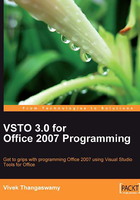
上QQ阅读APP看书,第一时间看更新
What's new in VSTO 3.0?
VSTO 3.0 is loaded with a wide variety of new features, and reloaded with enhancements of some of the key existing features. VSTO 3.0's new features target Microsoft Office 2007 (Office 12) tools with new functionalities and enhanced existing features. Let's list some of the key new features that are available in VSTO 3.0 that improve Office solution development work:
- Document-level customizations: Document-level customizations are customized solutions that reside in a single document. Document-level customization using VSTO is one of the key features added in this new version of VSTO. VSTO supports document-level solutions for Microsoft Office Word, Microsoft Office Excel, and Microsoft Office InfoPath.
- Application level add-ins: Application level add-ins are created as a managed code assembly using VSTO that will be loaded when the relevant Microsoft Office application is launched. VSTO 3.0 provides access to .NET objects and controls that you can program directly.
- Visual Designers for Ribbons: Ribbons are the new way of organizing related commands. Visually, they appear as controls. Visual Designer provides advanced tools and supports developers in creating and designing custom Ribbons more easily.
- Task Panes: The Task Pane helps users to access information quickly and more conveniently. Task Panes can be shown or hidden in the Office application user interface depending on the user's preference.
- Form regions: Form regions are new ways to customize the user interface of the standard Microsoft Office Outlook 2007. For instance, VSTO 3.0 provides a Windows Forms-based design and development environment, in Visual Studio 2008. This allows Office developers to design and code the new Outlook form regions in single development environment and brings most of the Windows Forms to the hosting environment of Outlook.
- Workflow support: VSTO provides visual designer support for developers to create Workflows using Visual Studio 2008. A Wizard option is used to create Workflows and directly assign these to the deployment location.
- SharePoint support: New objects in VSTO help developers to program in Office applications for SharePoint. You can extend your Office client applications using VSTO and integrate them with a SharePoint Portal into an enterprise solution such as Customer Relationship Management, Supply Chain Management, and other similar applications.
- Deployment using ClickOnce: New for VSTO 3, ClickOnce deployment technology allows Windows-based applications to be deployed and run with minimal user interaction. The security zone will limit the permissions and actions for applications that are deployed using ClickOnce technology.
- Word content controls: Content controls are containers within which specific types of content, such as dates, lists, pictures, or text, can be placed.
- Rich user interface controls: Office solutions can be built with rich and easy-to-access user interfaces. For instance, you can create an actions pane with windows controls, which has data interaction with other data sources in the actions pane.
- Support for other Office applications: There is even a complex object model for Visio, which is somewhat different from the other Office applications, and can be challenging to understand. In Visio, each shape is represented as an object that you drag-and-drop onto the page from stencils. Understanding and manipulating these objects is the key to creating Visio applications solution.